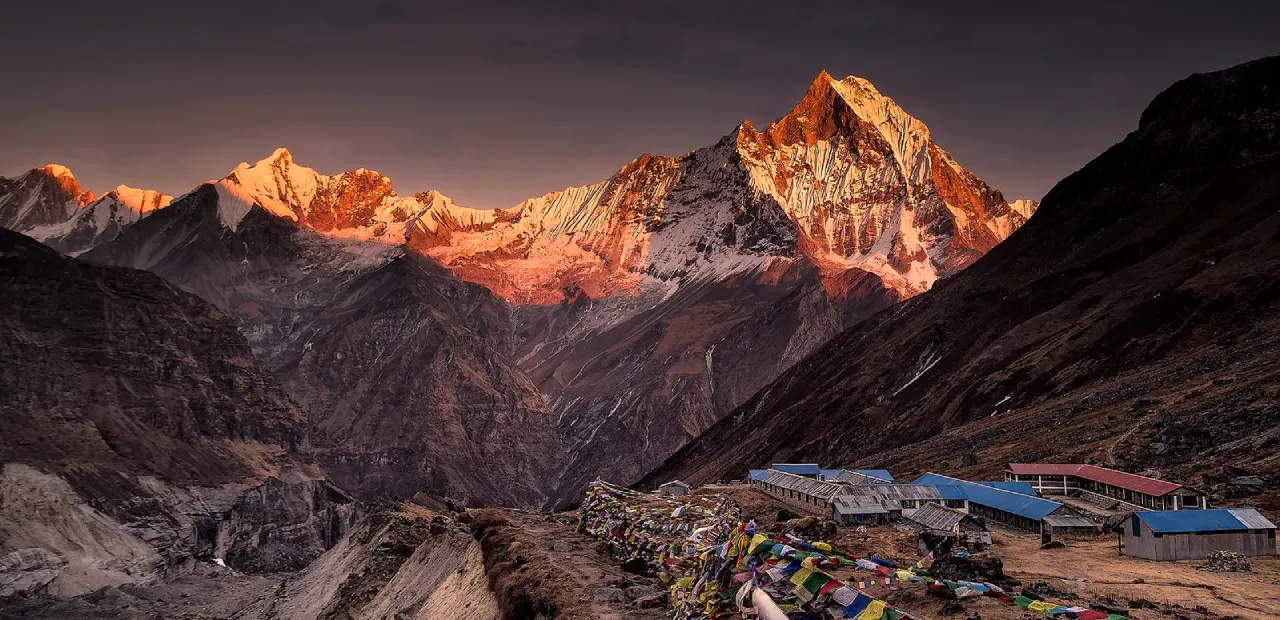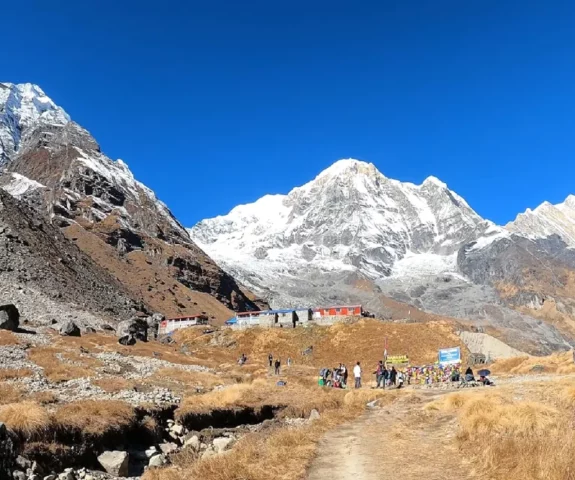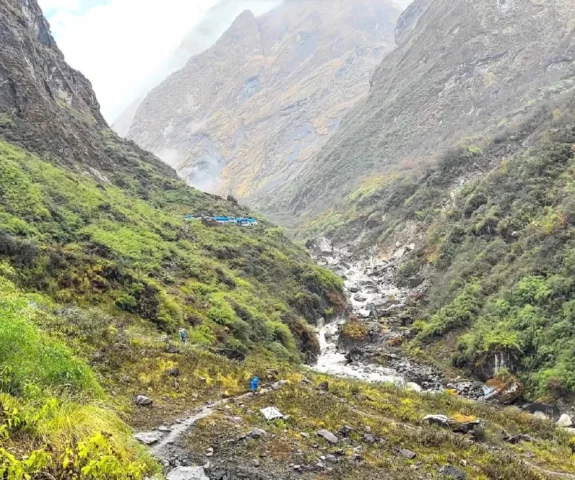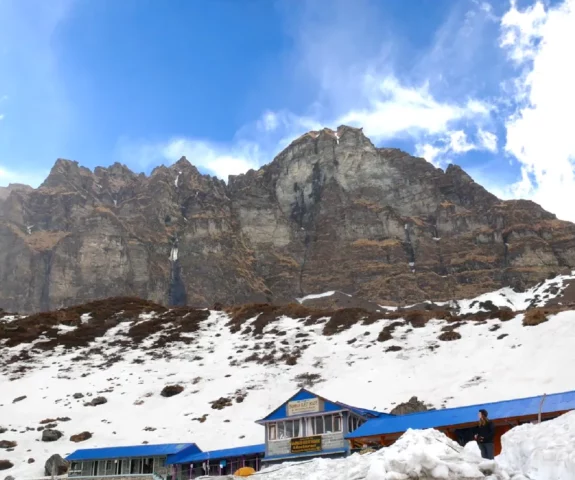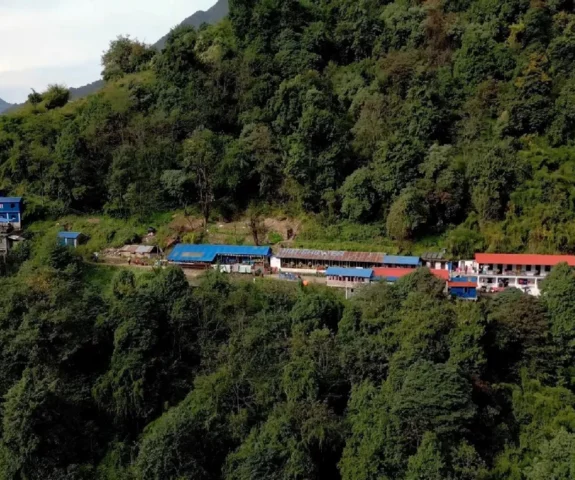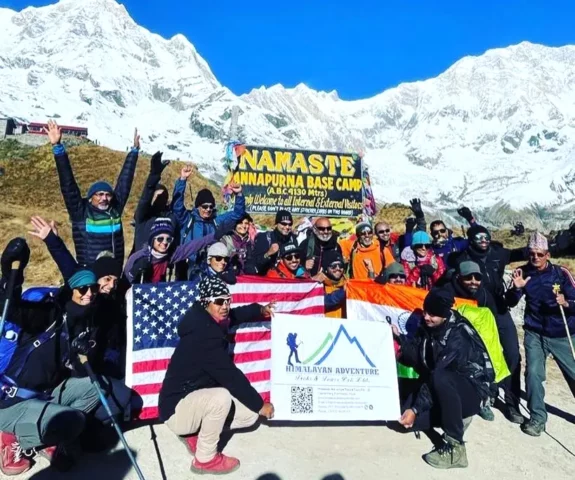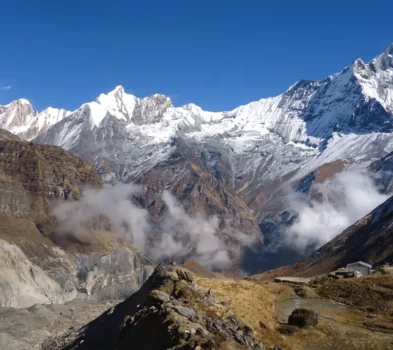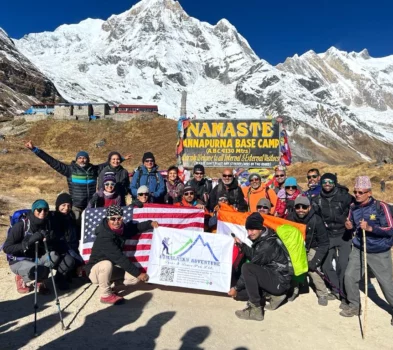Duration
8 DaysShort Annapurna Base Camp Trek
Trip Grade
ModerateGroup Size
1-16 PeopleMax Altitude
4,130m. / 13,550ft.Best Season
Feb- May/ Sept- NovActivity
Trekkling & HikingMeals
Breakfast, Lunch & DinnerAccommodation
Hotels & TeahousesTransportation
Private Vehicle & FlightTrip Customization
On request (click here)Highlights of Short Annapurna Base Camp Trek
- Unexpectedly beautiful scenery of Annapurna I, Machhapuchhre, and Hiunchuli.
- Panoramic view of Himalayan peaks and Sunrise at Annapurna Base Camp.
- Hiking in the green rhododendron and bamboo forests.
- Visiting attractive Gurung and Magar villages such as Chhomrong and Ghandruk.
- Driving over suspension bridges and raging mountain rivers.
- Spending free time in Jhinu Danda hot springs.
- Varied sceneries of terraced fields up to alpine meadows.
Trip Introduction
The Short Annapurna Base Camp Trek is an ideal way to start the Himalayas since it is a mixture of natural beauty, mountain adventure, and culture. This hike will see us going through the center of the Annapurna area, which is one of the most popular trekking destinations in Nepal.
It suits people who have a limited time and desire to see the high mountain landscape, various landscapes, and Nepal traditional villages. This walk normally begins at Pokhara, which is a beautiful city that has lakes and mountainous scenes, and takes approximately 7-8 days to finish.
In the Short Annapurna Base Camp trek, we traverse through some picturesque villages such as Nayapul, Chhomrong, Bamboo, and Jhinu Danda. Every village has its own peculiarity and dwells upon its own local inhabitants, mostly Gurungs and Magars, who enjoy welcoming hospitality.
We also get an opportunity to observe the standard Nepali culture, such as terraced agriculture, residential structures, and village lifestyle. Meanwhile, we meet villagers and get to know their customs and traditions as well as their celebrations.
The Short Annapurna Base Camp Trek is an amazing experience with breathtaking sights of the high mountains of the world. There are mountains such as Annapurna I (8,091m), Annapurna South, Machhapuchhre (Fishtail), Hiunchuli, and Gangapurna that surround us.
At 4,130 m of Annapurna Base Camp, we have a 360 panoramic view of snow-capped mountains, glaciers, and deep valleys. The ABC sunrise and sunset are incomparable since the golden light bathes the white mountains and reflects on the surrounding landscapes.
The Short Annapurna Base Camp Trek trail is, in itself, varied and adventurous. We pass through rhododendron and bamboo forests, cross rivers in suspension bridges, ascend in staircases of stone and boulders, and walk through waterfalls and streams.
On its way, there are different plants and colourful flowers, and at times even Himalayan birds and small animals. The expedition is not very strenuous, as it consists of moderate ascents and easy descents, and thus it is suitable for both amateurs and professional trekkers.
The Short Annapurna Base Camp Trek is an adventure, nature, and cultural trekking trip. It provides us with an intimate impression of the Himalayas of Annapurna, the opportunity to live in traditional mountain villages, and the possibility to spend time in peaceful forests, rivers, and hot springs.
The hike will be remembered forever in terms of the amazing mountain views, welcoming people, and cozy Himalayan climate. It is a perfect hiking experience that one would like to have, a short yet very memorable Himalayan trip in Nepal.
Outline Itinerary of Short Annapurna Base Camp Trek
Day 01: Arrival in Kathmandu
Day 02: Fly from Kathmandu to Pokhara (822m), drive to Nayapul, and trek to Chhomrong (2170m).
Day 03: Trek from Chhomrong to Himalaya (2,920m)
Day 04: Trek from Himalaya to Annapurna Base Camp (4,130 m)
Day 05: Trek from Annapurna Base Camp to Bamboo (2,310m)
Day 06: Trek from Bamboo to Jhinu Danda Hot Springs (1,780m)
Day 07: Drive from Jhinu Danda to Pokhara via Birethanti & Fly to Kathmandu (1,400m)
Day 08: International Departure
Our guests sharing their experiences (Photo/Video Gallery)
Detail itinerary of Short Annapurna Base Camp Trek
Day 01: Arrival in Kathmandu
Your Short Annapurna Base Camp Trek is starting as you arrive at Kathmandu at Tribhuvan International Airport.
Upon arrival, we will have an easy-going staff who will meet you and help carry your bags. You will be transported to the hotel in a comfortable and private vehicle after a warm reception.
The ride takes only a short drive, during which you can have the pleasure of the first sight of the crowded streets and local color of Kathmandu.
Once you have been admitted into the hotel, you will have some time to sit back and rest after the flight. In case you are early, you can sightsee around, go to local stores, or have the traditional Nepali food.
Early in the evening, your trekking guide will have a briefing session with you on the trip ahead.
They will elaborate on the itinerary, hiking path, safety precautions, and equipment list. This will make you get ready to go on the adventure.
You will stay overnight in a pleasant hotel in Kathmandu, and the following day you will be ready to begin your adventurous journey in the beautiful Annapurna region.
Activity: Airport Pickup, 30 min
Max. Altitude: 1,400m/4,593ft. Kathmandu
Accommodation: Hotel
Day 02: Fly from Kathmandu to Pokhara (822m), drive to Nayapul, and trek to Chhomrong (2170m).
We then fly on a short and picturesque flight after breakfast out of Kathmandu to Pokhara. We spent the 25 minutes of the flight with wonderful views of the Himalayas with the Manaslu and Annapurna ranges, the green hills, and twisting rivers below.
When we reach Pokhara, we drive to Nayapul, which is a small and vibrant village with green hills and farmlands, and where we begin our trek.
We start off our walk at Nayapul, heading towards Chhomrong. The path goes through serene villages, terraced lands, and rhododendron woods.
On our way, we see friendly locals and have a glimpse of their simple village life. The closer we get to the high altitude, the grander the peaks of Annapurna and Machhapuchre (Fishtail) look.
After travelling around 7-9 hours, we arrive at Chhomrong, a lovely Gurung village, whose mountain views are breathtaking, and we spend the night there.
Activity: 25min flight, 1hr drive & 6-7hrs trek
Max. Altitude: 2,170m/7,119ft. Chhomrong
Meal: Breakfast, Lunch & Dinner
Accommodation: Teahouse
Day 03: Trek from Chhomrong to Himalaya (2,920m)
Following breakfast, our journey begins in Chhomrong, and we start with a walk by passing through stone steps and a suspension bridge over the Chhomrong Khola River.
We then ascend up through dense forest where there are bamboo, oak, and rhododendron trees. The path is serene and green, and there are birds and waterfalls.
As we continue climbing uphill, the air cools down, and we get glimpses of Machhapuchhre (Fishtail) and Annapurna South coming out of the forest.
We go through small villages and tea houses where we can sleep and receive the local hospitality. The road slowly takes us to a secluded spot known as Himalaya with cliffs and green hills.
Himalaya is a small, attractive detour of the road to Annapurna Base Camp. It also has breathtaking mountain landscapes and a serene atmosphere, which is ideal after a long and scenic day of trekking.
Activity: 6-7 hrs trek
Max. Altitude: 2,920m/9,580ft. Himalaya
Meal: Breakfast, Lunch & Dinner
Accommodation: Teahouse
Day 04: Trek from Himalaya to Annapurna Base Camp (4,130 m)
Our trip to the Himalaya ends after breakfast and starts with a visit to the well-known Annapurna Base Camp. The path initially follows a thick bamboo and rhododendron forest, where we might be able to see coloured birds and little creatures.
As we get up in altitude, we begin to see the trees thinning out, and we are then in a rocky and alpine terrain with high cliffs and glacial streams.
We go through Deurali and Machhapuchhre Base Camp (MBC), where the sights of Machhapuchhre (Fishtail) are simply spectacular. It is an uphill trail, which slowly leads to Annapurna Base Camp, which is encircled by snow-white mountains.
On our way to ABC, we are greeted by the sight of the grand Himalaya range, which houses Annapurna I, Hiunchuli, and Gangapurna.
The base camp is serene and magical with breathtaking mountain views in 360 degrees and a cold but cool atmosphere. We pass the night here, marvelling at the wonderful beauty of the Himalayas.
Activity: 6-7hrs trek
Max. Altitude: 4,130m/13,550ft. Annapurna Base Camp
Meal: Breakfast, Lunch & Dinner
Accommodation: Teahouse
Day 05: Trek from Annapurna Base Camp to Bamboo (2,310m)
We get up in the early morning to view the beautiful view of sunrise on the Annapurna range. The golden rays fall on the snow-white mountains of Annapurna I, Machhapuchhre, and Hiunchuli to produce what is indeed a magic sight.
We start to go down the base camp after having breakfast, and we use the same way back to the Machhapuchhre Base Camp and Deurali.
The scenery gradually changes on our way down the mountain as we come across the Rocky Mountains and then have the green forests. We go through bamboo and rhododendron woods, and the air is fresh and cool.
On the way, we can see the birds and little animals in the thick vegetation. We are accompanied all the way by the sound of falling rivers and waterfalls.
After trekking close to 5-6 hours, we arrive at Bamboo, a quiet village enclosed by dense bamboo forests. It is an ideal destination to have a good rest and have rest after a long working day and enjoy the natural beauty around.
Activity: 5-6hrs trek
Max. Altitude: 2,310m/7,579ft. Bamboo
Meal: Breakfast, Lunch & Dinner
Accommodation: Teahouse
Day 06: Trek from Bamboo to Jhinu Danda Hot Springs (1,780m)
We walk out of Bamboo after breakfast and begin to explore the beautiful forests with bamboo, oak, and rhododendron trees. The path is up and down over green hills and the fresh mountain air, and the sound of streaming rivers.
We pass by small villages in the middle of the way, where we can observe local people working in the fields and smiling children welcoming trekkers.
Temperatures become increasingly warmer as we head down the road, and the forest thickens, with a lot of birds and colorful plants.
We then walk further, after some 5-6 hours, to Jhinu Danda, a beautiful village on the hillside, which has natural hot springs.
Five minutes of downward passage of the village takes one to the hot springs on the banks of the Modi Khola River.
In this instance, we have the opportunity to relax that tired body in the warm water and also listen to the serene flow of water in the river and the greenery. It is an ideal end of the day.
Activity: 5-6hrs trek
Max. Altitude: 1,780m/5,840ft. Jhinu Danda Hot Spring
Meal: Breakfast, Lunch & Dinner
Accommodation: Teahouse
Day 07: Drive from Jhinu Danda to Pokhara via Birethanti & Fly to Kathmandu (1,400m)
On the day after breakfast, we start our last day of the trek. From Jhinu Danda, the trail is taken down the Modi Khola river on its way to the green hills and terraced fields.
This trail is quiet and replete with nature and small waterfalls, birds chirping, and flowers are on the trail as well.
Then, after a short time, we arrive at Birethanti, a beautiful forest-fringed village on the bank of the river. It is a bustling place where trekkers have a habit of taking a break and having local tea or food.
We drive back to Pokhara, a short distance, with Birethanti. The road is made along picturesque mountain valleys, and it has the advantage of giving beautiful scenery of hills, rivers, and villages.
We have a brief flight back to Kathmandu once we have reached Pokhara, where we get one last glimpse of the dominating Himalayas.
We spent some time in Kathmandu at the hotel, reminiscing about our great Annapurna Trek.
Activity: Trek, Drive & Flight, 6-7 hours
Max. Altitude: 1,400m/4,593ft. Kathmandu
Meal: Breakfast
Accommodation: Hotel
Day 08: International Departure
It is the last day of our great Short Annapurna Base Camp Trek. Having had breakfast, we have some time to relax and pack our bags, with the beautiful memories of our Himalayan adventure still in our minds.
You can spend some spare time to explore Kathmandu, depending on your schedule of flight schedule, go to local markets, purchase souvenirs, or just sleep in the hotel.
Our team will help you with the transfer to Tribhuvan International Airport in a comfortable and personal vehicle.
When we finally drive through the bustling streets of Kathmandu, we are able to look back and see the wonderful trip where we saw beautiful mountains, hospitality, and the villages.
At the airport, we will assist you with the check-in and send you off on your trip home. We bid our farewell in hope of meeting once more to have another memorable trekking experience in the beautiful Himalayas in Nepal.
Activity: Airport drop, 30 min
Max. Altitude: 1,400m/4,593ft. Kathmandu Airport
Meal: Breakfast
Note:
If you have your own private group and want to make your trip private, we can run the custom trip all the day as per your requirements and group size.
Includes and Excludes
What are included with package?
- Airport Pickup and Transfer: You will be greeted at the airport and transferred to your hotel in Kathmandu upon arrival.
- Two Nights Accommodation in Kathmandu: Stay in a comfortable 3-star hotel in Kathmandu, with breakfast included.
- Meals During Trekking: All meals (breakfast, lunch, and dinner) are provided during the trekking days at local tea houses.
- Flights from Kathmandu to Pokhara and Back: Round-trip flight tickets between Kathmandu and Pokhara are included.
- Private Vehicle Transportation: Transportation by private vehicle between Pokhara and Nayapul, and from Jhinu to Pokhara.
- Trekking Permits: Includes necessary permits such as the Annapurna Conservation Area Permit (ACAP) and the Trekkers’ Information Management System (TIMS) Permit.
- Accommodation During Trek: Stay in tea houses (lodges) during the trekking days for a comfortable and authentic experience.
- Guide and Porters: A licensed and friendly guide will accompany you, along with porters (one for every two clients) to carry your gear.
- Travel Rescue Services: Emergency travel rescue arrangements are included to ensure your safety during the trek.
- Trekking Gear: A duffel bag is provided for carrying your gear, and you will receive a company T-shirt as a souvenir.
- Medical Supplies: A first aid kit will be available throughout the trek to address any minor health issues or injuries.
- Farewell Dinner: Enjoy a farewell dinner at a traditional Nepalese restaurant in Kathmandu, including a cultural performance to end your trip on a memorable note.
What are not included with package?
- Nepal Visa Fee: You can obtain your visa on arrival at Kathmandu Airport. The fee depends on the length of your stay in Nepal.
- International Airfare: Flights to and from Kathmandu are not included. You will need to arrange and pay for these separately.
- Travel and Rescue Insurance: It’s essential to have travel and rescue insurance that covers trekking in Nepal. This is not included in the package.
- Personal Expenses: Any personal costs, such as phone calls, laundry, bar bills, or items you purchase, are not covered.
- Tips: Tips for the guide and porter are not included. It’s customary to tip them at the end of your trek to show appreciation for their services.
Pick Your Suitable Date
Book a Private Trip
Private & Group Discount Price
-
1 -
1 person
US$ 1200
-
2 -
2 people
US$ 800
-
3 -
5 people
US$ 750
-
6 -
10 people
US$ 650
-
11 + people
9999
US$ 550
Total Cost:
US$ 1200
Route Map & Altitude Chart
Kathmandu
Start/End point
Kathmandu
Trip Information
Best Time
The Short Annapurna Base Camp Trek may be performed in any season of the year, though the experience is different with every season. March to May (spring) is also one of the best months to trek. The weather is warm and clear, and the rhododendron forests are also in bloom, and they add bright colors to the trails.
Mountain scenery is clear at this time of the year, and wildlife and birds are more active. The trail cannot be as empty in certain places, however. Wearing layers, having sunscreen, and having rain protection are also advisable, because there are rains that take place every now and then.
Heavy rainfall comes in the summer/monsoon (June to August). The woods are green and cool, and waterfalls are in space. The trails might, however, turn out to be slippery and muddy, and landslides may occur.
Mountain views are frequently covered with clouds; hence, it is not the best time to have clear views. This season is important because of waterproof jackets, shoes that have a good grip, and insect repellents.
Another great season of trekking is in autumn (September to November). The climate is predictable, and the skies are clear with the best views of Annapurna, Machhapuchhre, and other surrounding mountains.
Local festivals are also a good experience during this period. Trekking is comfortable at such temperatures, and there is no overcrowding on the trails when the season is early. Trekking layers, sunglasses, and a warm jacket that is lightweight jacket are suggested.
Later, during winter (December to February), it gets colder, particularly in the higher altitudes. The tracks are not as busy, and the air is clean and pure with breathtaking scenery of the snow-covered mountains. But in the mornings and nights, it is very chilly, and some teahouses might not furnish themselves much. It is necessary to wear warm clothes, gloves, hats, and thermal layers.
The most popular and comfortable seasons are spring and autumn, and summer and winter have their own experience. The trekking tour in the Annapurna region is safe and has enjoyable moments in proper preparation, which is based on the season.
Distance and Elevation
The Short Annapurna Base Camp Trek is a moderate-level trek that is a mixture of easy days of hiking, stunning mountain views, and cultural experiences. It is also one of the significant features of this trek to determine the elevation and distance, which will enable us to prepare physically and mentally.
This trek begins with a brief flight from Kathmandu to Pokhara, and then a drive to Nayapul, the trek’s starting point. We leave Nayapul and ascend gradually through the villages and forests to Chhomrong (2,170 meters, 7,119 feet) on the first day of the trek.
On the way, we hike to the Himalaya, 2,920 meters (9,580 feet), seeing rhododendron and bamboo forest, waterfalls, and streams. The peak of the hike is Annapurna Base Camp at 4,130 m / 13,550 ft., at which we have a fantastic 360-degree view of the snow-covered Himalayan mountains.
We go down to Bamboo 2,310 meters (7,579 feet) and Jhinu Danda Hot Springs 1,780 meters (5,840 feet) in the base camp. The expedition culminates at the Birethanti/ Pokhara at the lowest point of c. 822 m / 2,700 ft. in Pokhara. This demonstrates that the trek is very diverse in terms of elevation levels, with the low hills and the high mountains that allow us to have diverse experiences with every step.
Cumulative distance taken in the trek is roughly 70-80 kilometers (which comprises all walking days between Nayapul and Annapurna Base Camp and back to Pokhara). The trekking days are mostly 5-7 hours of trekking with slow uphill and downhill hikes that allow beginners and experienced trekkers to enjoy the trek.
The ascents and distances give a fair trekking adventure – lush green valleys to high alpine areas. This trek is very safe and memorable with proper preparation, slow acclimatization, and taking time to have a view of the places.
Difficulty and Altitude Sickness
The Short Annapurna Base Camp Trek can be described as a moderate trek, which can be done by both beginners and experienced trekkers with a basic fitness level. The steep consists of slow uphill and downhill steps, some of which are steep, stone steps, and walks through the woods. The average trekking day is between 5 and 7 hours, and it can be dealt with by individuals who are well prepared and take rest when necessary.
It does not involve technical climbing, and an average amount of stamina and endurance would be beneficial for the trek to have a comfortable journey. The paths are clearly outlined, and the number of tea-houses and places of rest on the road is sufficient to keep the strength and speed up.
Altitude sickness is one of the significant factors in trekking in the Himalayas. This happens when the body fails to adapt to increased altitudes because of reduced oxygen levels. The tallest in this trek is Annapurna Base Camp and is 4,210 meters (13,812 feet).
The majority of trekkers are able to reach this height without any problems, provided they do it in stages, remain hydrated, and take frequent rests. Mild altitude sickness symptoms include dizziness, shortness of breath, headaches, and nausea. The symptoms are not severe in this trek, but can still be serious, so care must be taken, and one should not hurry.
To avoid the occurrence of altitude sickness, we suggest that one walk gradually, consume a lot of water, eat light meals, and give the body time to adapt. Seriously, do not take alcohol and overstrain at elevated levels.
If an individual is unwell, it is possible to experience relief by merely going down a few meters in altitude. Our trekking leaders are knowledgeable in tracking the trekkers in terms of altitude, and such knowledge can guide or support them in case of need.
The short Annapurna base camp trek is not very difficult, yet it is quite manageable by the majority of healthy people. Having correct preparation, pacing, and care of altitude sickness, trekkers will be able to enjoy this beautiful Himalayan adventure safely and comfortably, and see amazing mountains, forests, and villages.
Minimal and Maximum walking hours per day
The Short Annapurna Base Camp Trek is made to be comfortable but adventurous, with the walking hours taken into consideration to take into account the scenery and the fatigue at the same time, easy to handle. The trekking days typically range between 5 and 7 hours per day based on the distance, terrain, and elevation that needs to be covered on that specific day.
Day 02, Nayapul-Chhomrong, is normally the day that we walk the most. The day is about 6-7 hours long and involves gradual ascents through forests, villages, and terraced fields. The path runs through rivers, hanging bridges, and beautiful vistas, and it is a lengthier yet gratifying day.
The other long day will be the walk between the Himalaya and the Annapurna Base Camp (Day 04), which is another 6-7 hours, but will feature steeper climbing as we head to the high alpine region. These extra days need stamina, frequent breaks, and good hydration to enjoy the trek without having any problems.
Day 07 is the day that has the least amount of walking, and it is largely a mixture of a short walk, a drive, and a flight between Jhinu Danda and Pokhara with a flight to Kathmandu.
Only 2-3 hours of casual walking are involved in this day, which is mostly a downward movement to Birethanti and to the road. It also provides the trekkers with an opportunity to rest and enjoy the lower hills and absorb the scenery without having to take a hard hiking route.
Trekkers walk an average of 5- 6 hours a day. The paths are different stone steps and woody walks, crossings of the rivers, and open alpine ways, which make the walk not boring but just beautiful. Short rests at teahouses or viewpoints are included on most days and assist the trekkers in taking things slowly.
The trek maintains a balance of difficult days of hiking with less difficult days of hiking so that trekkers can have an adventure in the high mountains and a relaxing stroll through the forests, thus making the Short Annapurna Base Camp Trek a possibility and an easy-going experience for all people with moderate fitness.
Accommodation, food, and drinks
In the Short Annapurna Base Camp Trek, hotels and food are fixed to make your stay comfortable and pleasurable. During the course of the trek, we spend the night in tea houses or lodges.
These lodges are not fancy and are clean with basic amenities like a bed, some blankets, and some shared or personal bathrooms. By spending time in these local lodges, we will be able to enjoy the optimum hospitality of the mountain communities and experience the serene atmosphere of the Himalayas.
The lodges serve meals on the trek they are breakfast, lunch, and dinner:
- Breakfast usually consists of such foods as eggs, porridge, toast, pancakes, or local bread with tea or coffee.
- Lunch is inexpensive and nutritious, such as dal bhat (rice with lentil soup), noodles, soups, or sandwiches.
- Dinner is also typically the same, as one may choose rice, vegetables, soups, and even meat (depending on availability). These meals give us the power necessary for a long trekking day, and keep us healthy and strong.
Although the main meals are included, other items, like snacks, chocolates, soft drinks, juices, mineral water, or alcohol, are to be paid for separately. To stay up all day, it is a good idea to bring some of your personal snacks, energy bars, or beverages to the trail in case of the longer days of walking.
Most lodges come with water; however, it is advisable to come with water purification pills or to carry a water bottle in case. Hot drinks, tea, and coffee are also readily available, and they are best in cold weather.
Short Annapurna Base Camp Trek promises good accommodation, healthy food, and convenient access to beverages, besides enabling the trekkers to experience the local culture and mountain hospitality. It is possible to make some extra snacks or individual beverages to make the hike even more pleasant.
Alternative Routes
The main trail of the Short Annapurna Base Camp Trek is that of Nayapul to Chhomrong, Himalaya, Bamboo, and Jhinu Danda to the Annapurna Base Camp, but it has a number of alternative routes through which a trekker could follow to know this region of the Annapurna better. These alternatives can either transform the trek into something more adventurous, or something more time, fitness, and interest specific.
Among the most commonly used variants is the decision to begin the trek at Ghandruk, rather than Nayapul. This is a little way shorter and is breathtaking with Machhapuchhre (Fishtail), Annapurna South, and Hiunchuli. Ghandruk is also a common Gurung village where the trekkers can get to learn more about the local culture, local village life, and hospitality before proceeding to Chhomrong, and proceed to ABC.
The other alternative is making a diversion at Chhomrong to Sinuwa or Deurali. The route takes one through less busy trails, forested areas, and falling streams, which make the trekking experience of the trekkers a less noisy and more enjoyable experience. It is also associated with the fact that it can be better acclimatized to higher altitudes.
Some trekkers want to add an additional day at Machhapuchhre Base Camp (MBC) or even to Dovan for better sightseeing of glaciers, cliffs, and the Himalayan mountains.
Also, some trekkers take an inverted path where they begin their journey at Jhinu Danda and end at Nayapul. A softer approach to ABC can be done, and this can aid in the process of acclimatization, and the likelihood of altitude sickness can be minimized.
There are other paths to use, all of which have access to teahouses and lodges, as well as other local facilities, which make them comfortable and safe. They can alter the total distance or the amount of time to walk here and there, yet the scenic beauty, cultural experience, and mountain views are equally magnificent.
The Short Annapurna Base Camp Trek is accommodating and allows various approaches to reach the base camp as the trekkers tour various villages, forests, and viewpoints, and entails customizing the experience according to time and taste.
Can a beginner join this trek?
The short Annapurna Base Camp Trek can be completed even by a beginner, with the right preparation and the right attitude. The trek is regarded as moderate in nature and therefore does not require technical skills in climbing or prior experience in trekking.
The daily routine is mostly 5-7 hours of walking slowly up and down, which is not very difficult for a person with simple fitness. The novices ought to make prior preparations before the trek. Stamina can be developed by engaging in simple things such as walking, jogging, or using stairs a few weeks before the event.
When climbing the mountain, trekking poles may be used to take the pressure off the knees on uphill and downhill slopes. One should also walk slowly, take numerous breaks, and hydrate during the hike.
The other aspect is altitude. Annapurna Base Camp, located at 4210 meters (13812 feet), is the highest point of the trek. The novices can safely do it with a step-by-step approach, as it gives time to make the body accustomed and to listen to it.
The symptoms of mild altitude sickness may be headaches or the feeling of dizziness, but they may be relieved through examples of rest, water, and the absence of hurry. Guides are trained to follow the trekkers and give them advice where necessary.
The physical requirements are not the only reasons why the trek is beginner-friendly, since the trail has comfortable lodges and tea houses. These offer food, sleeping places, and rest areas, and thus novices will not have to carry the bulky camping equipment.
The Short Annapurna Base Camp Trek is the ideal destination for novices who want to explore the Himalayas. The Himalayan Mountain is a safe and memorable travel for any middle-average fitness person by just being prepared, pacing, and understanding the altitude.
Preparation and Fitness
It is better to prepare before going on the Short Annapurna Base Camp Trek to have a comfortable and safe trip. The expedition is a task that requires days of walking around, many hours a day, hiking rugged paths, and camping in places of elevation.
Although it is not a complicated path and can be achieved by beginners and average trekkers, it is better to prepare physically and plan the trip to enjoy it. The preparation for fitness must begin a few weeks before the trek. Stamina and strong leg muscles can be obtained by means of simple exercises such as walking, jogging, cycling, or climbing stairs.
Balance Hiking sticks can be used to ease pressure on the knees on the uphill and downhill parts. Stability during the process of carrying a small daypack can also be enhanced with core exercises, such as sit-ups or planks. One can train walking with a pack before the expedition to ease the body used to carrying equipment.
Other than being physically fit, it is also important to be mentally prepared. The trekkers are advised to be prepared to spend long days walking, fluctuating weather, and the simplest of accommodation conditions in the mountains. The trek will be more enjoyable in the presence of a positive attitude and patience.
Equipment beforehand is important. Warm jacket, hat, gloves, and rain protection are required, as well as comfortable trekking shoes and layered clothing according to the weather conditions. Sunglasses, sunscreen, and a water bottle are also advisable.
Acclimatization is essential as we go higher. Altitude sickness can be avoided by walking at a consistent pace, taking rest, and staying hydrated.
With proper preparation and fitness, the Short Annapurna Base Camp Trek is safer and more rewarding. Trekking with stamina, the right equipment, and the mindset of change can ensure that the trekkers can experience the magnificent mountain ranges, forests, rivers, and the special culture of the Annapurna region. A Himalayan adventure is easy, enjoyable, and safe when prepared.
Internet, Gadget Charging, and Communication.
Staying in touch and charging your devices is possible when walking in the Short Annapurna Base Camp Trek, although there are a few things to consider beforehand. Most of the tea houses and lodges along the trekking route have basic electricity, where phones and cameras, among others, can be charged.
Nevertheless, electricity can be scarce and availed at a low cost. The power supply may also be irregular, and it is always good to carry a power bank to keep your devices powered all day.
During the trek, communication is possible, although the coverage of the mobile phones is different. Mobile network coverage in some of the lower regions, such as Nayapul, Chhomrong, and Bamboo, is usually good and provides the chance to make calls and send messages.
As you climb up towards the Himalaya and Annapurna Base Camp, there is a weakening or even loss of network signal. Family and friends should be informed about these areas because they will always know that there will be limited communication in some parts of the trek.
The internet is accessible in a few of the lodges and tea houses, particularly in the bigger villages, although the internet is slow and not dependable. Wi-Fi can be provided either at a minimal charge or as a meal or accommodation service.
The use of the internet by most trekkers is minimal during the trek, and this also provides an excellent chance to explore the mountains and the natural environment without distractions.
To be safe, it is advisable to have vital telephone contacts and use your trekking guide, who would be able to communicate in case of an emergency. The use of cameras, phones, and other gadgets should be prudent because their battery life may be short-lived, and they might not always have a place to charge their batteries.
Although charging gadgets, contacting, and accessing the internet can be done, it is recommended to expect weak connectivity. To bring power banks and charge devices where possible and go on the trek without being connected to the internet regularly can transform the Short Annapurna Base Camp Trek into a calmer and more enjoyable experience.
Permit
To trek in the Annapurna region, you need permits to protect nature and support local people.
For the Short Annapurna Base Camp Trek, you need two permits: the Annapurna Conservation Area Permit (ACAP) and the Trekkers’ Information Management System (TIMS) Permit, as well as a licensed guide to guide you throughout the trek.
The ACAP is needed because the trek goes through the Annapurna Conservation Area, which helps protect the land, animals, and villages. It also makes sure that the trekking activities are done in a professional way with minimal effects on the environment.
Nepal Tourism Board issues the Trekkers Information Management System (TIMS) Permit. It also aims at monitoring the number of trekkers in the area and keeping them safe. The TIMS permit contains details of the trekker, route, and emergency contacts, and this information comes in handy in the event of accidents and emergencies.
Our team will do all the documentation and permit arrangements for our guests. You need not bother going to offices and filling forms. The trekking package encompasses both the ACAP and the TIMS permits and thus, you can be able to concentrate on the trek. Our guides shall have copies of the permits and will make sure that they are verified at the entrance and exit points along the trail, and this is a normal practice in the area.
We handle the permits on your behalf so that it will be an easy, convenient, and stress-free process. You need not worry that your trekking adventure is not legal, safe, and eco-friendly. With the permits on board, you can enjoy the breathtaking landscapes, mountain sceneries, and even the cultures of the Short Annapurna Base Camp Trek without the administrative hassles.
This departs for the destination, and the ride is worthwhile.
Transportation
The Short Annapurna Base Camp Trek is an activity that involves transportation of the affected, and so the movement is comfortable, convenient, and easy. During the tour, we travel by private cars depending on the size of the group, such that all the tourists have a comfortable journey. Starting the moment you come to Kathmandu, our vehicles are ready to receive you at the airport and drive you to your hotel safely.
On day 2, we make a short flight from Kathmandu to Pokhara, which provides beautiful aerial views of the Himalayas, green hills, and rivers. Once in Pokhara, we drive to the starting point of the trek, known as Nayapul, using private vehicles. The route is picturesque, going through little villages, agricultural land, and the valley of rivers. Our cars are in good condition and offer a comfortable and safe ride, which gives you the power to begin trekking.
On the last day after the trek, we are transported by private vehicles between Jhinu Danda and Pokhara through Birethanti. It is a scenic experience as we travel on the road and see the beautiful sights of forests, rivers, and hills, and we are allowed to make brief stops and take photographs. Pokhara to Kathmandu is a short flight, and we do it most efficiently and comfortably, thus giving a proper conclusion to the transportation aspect of the trek.
We can also customize our transportation based on the group’s budget or preferences. You want small or big vehicles, air-conditioning, or simple, comfortable vehicles; there can always be arrangements to make it to your liking.
The Short Annapurna Base Camp Trek has transportation to ensure that the journey is comfortable, safe, and easy. By means of personal cars, airplanes, and carefully organized transfers, travelers do not have to be distracted by the logistical issues, and they can enjoy the trekking experience with the participation of the beautiful scenery and mountainous landscapes. A comfortable journey will bring a good beginning and ending to this memorable Himalayan experience.
Insurance
Although hiking in the Himalayas is a thrilling experience, one should always be ready when something goes wrong. The Short Annapurna Base Camp Trek does not require travel insurance, but it is highly suggested as a form of security and tranquillity.
Depending on the circumstances that may arise during the trek, insurance may include most of them, which include medical emergencies, accidents, evacuation, or even cancellation of the trip.
Hiking in high altitude areas is a risky activity as it can be accompanied by falls, slips, or altitude diseases. Insurance is the factor that ensures you are insured in case of a disaster, and you would be able to receive immediate medical attention or a helicopter evacuation in case of an emergency.
In most typical travel insurance, it is possible to take out trekking up to Annapurna Base Camp (4,210 meters / 13,812 feet) without the insurance ceasing. You should make sure you examine your policy to be sure that it covers high-altitude trekking and any adventure activities.
It is necessary to mention that the trekking package does not include insurance. Phone calls should be made before the trek by trekkers. By insuring early, you will be sure that you will go on the trek without any concern that you are covered against unexpected events.
Although the Short Annapurna Base Camp Trek is an easy summit that most individuals can undertake with average fitness, it is only prudent to take some travel or trekking insurance. It gives you the feeling of safety, trust, and lack of worry so that you can be fully transformed to the breathtaking mountain ranges, the local culture, and the experience that is invaluable in the Himalayas.
What to expect
The Short Annapurna Base Camp Trek is an ideal combination of adventure, culture, and nature. Trekkers will be presented with an adventure of some of the most scenic landscapes of Nepal, including lush green valleys and terraced fields, high alpine forests, and snow-covered mountains.
The trek is suitable for both beginners and experienced trekkers who do not have ample time, since it is diverse and offers a number of experiences. The beautiful mountain scenery is one of the attractions. On the way between Chhomrong and Annapurna Base Camp, there are peaks such as Annapurna I, Annapurna South, Machhapuchhre (Fishtail), Hiunchuli, and Gangapurna.
It is an incredible experience to view the sun rising above these mountains on ABC and to have memories that one cannot forget. The trekkers can also view waterfalls, rivers, rhododendron forests, and bamboo forests along the trail, and these are particularly colorful during spring.
Another significant thing about the trek is the cultural experiences. The route goes through Gurung and Magar villages, where the people are a very welcoming sight to the trekkers.
We get to observe village life, terraces, local houses, and get to mingle with the villagers to have a glimpse of their tradition, festivals, and their day-to-day activities. The additional aspect of this real cultural experience is staying in tea houses and lodges.
The hike is not too difficult, but it is controllable. Walking will take up 5-7 hours a day, and it will include slow uphill and downhill walks. The route is highly indicated and there are teahouses with food and rest along the way, making it easy even for a beginner with basic fitness.
The Short Annapurna Base Camp Trek is an adventure that has the most beautiful mountain views, impressive forests, picturesque villages, and the excitement of getting to a high base camp of the Himalaya. It is an adventure trip that gives memorable experiences and memories of the stunning Annapurna region.
Essential Packing Gear List for Short Annapurna Base Camp Trek
If you have decided to go on the Short ( Rapid) Annapurna Base Camp Trek in Nepal, we assure you that you will have a fantastic time ahead. But what should you pack for your Adventure? What will be the right gear to make your trip more fabulous? To help you with this, we have compiled a packing list of essential items that you mustn’t forget to bring along.
- Passport ( min 6 months valid)
- Cash, credit card
- List of important addresses and contact details
- 2-3 passport photos (optional)
- Copies of all important travel documents (passport, visa, airline ticket, insurance policy, etc.)
- A sturdy 70 L trekking backpack which will be carried by your porter (please note that our assigned 1 porter will carry 2 clients’ luggage up to 20-25 kg.
Note: We will provide each participant with a spacious 70 to 75 L Company logo duffle bag to conveniently carry your trekking gear, which you have to return once the trek is complete. - A 30 L Daypack that has room for your essentials such as camera, mobile, Passport, important documents, water bottle, day use medicine, chocolate bars, raincoat, etc., which will be carried by you.
- Protective cover for a backpack or travel bag.
- Hiking Boots: Preferably ankle-high boots to prevent ankle sprain
- Regular Shoes: For small strolls and exploration around the city
- Second, a light pair of shoes and possibly sandals
- Micro Spikes or Ice Cleats for the winter trekking over snow and ice
- Gaiter for added protection in snow
- A rain and wind-resistant, lightweight down jacket for warmth, with a good helmet hood
- Summer-light, as well as winter warm clothing
- Quick-drying shirts made of synthetic fabrics
- Warm and cool vests or T-shirts
- Functional synthetic underwear
- Sports Bra for Female Trekker
- A waterproof pair of trousers
- Regular trousers of quick-drying fabric
- Hiking shorts
- Cargo Pants with multiple pockets to hold your small items, such as knives or chocolates
- Woolen or fleece pants
- Trekking socks, both thick and woolen fabric, and lighter wool socks
- Wool hat, gloves, and scarf
- A light cotton scarf or a bandanna for protection of your head, neck, ears, and mouth
- Sun hat, and sunglasses with 100% UV protection (for trekking trips, even with stray light and nose protection)
- Sunscreen cream or lotion with a high sun protection factor (at least 15, for trekking trip,s even at least 30)
- Sunscreen lipstick with a high SPF (at least 20, for trekking trips, even at least 30 or sunblock)
- Mosquito repellent (Optional)
- Comfortable light night clothes and shoes
- A drinking bottle that can be used as a hot water bottle on frosty nights
- Flip-flops or bathing shoes for using the showers
- Water purifiers: if you need to refill water from the tap or stream en route
- Headlamp: for a midnight or pre-dawn trip towards the viewpoint
- Quick-drying towel and sample-size toiletries for washing your feet and face
- Your Personal first-aid kit: with basic medical supplies such as bandages for sprains, antidiarrheal and antibiotics, iodine wipes for scrapes and cuts, plasters, aspirin, or ibuprofen, moleskine for preventing blisters, Diamox (acclimatizing medicine), and your Personal medication
- Sleeping bag appropriate for all-season treks (we can hire in Kathmandu)
- Waterproof money belt, chest bag, leg bag, or belt bag for storing important travel documents or valuables
- Toothpaste, Toothbrush, and soap
- Deodorants
- Moisturizer
- Nail clippers
- Feminine hygiene products (Sanitary Pads)
- Small mirror
- Wet wipes
- Hand sanitizer
- Comb
- Camera with sufficient memory cards and spare batteries, or a battery charger
- Small padlock for your travel bag
- Crampons ( during winter, Dec- Feb)
- Thermos flask
- Water bag
- Toilet paper (2-3 rolls without)
- Ear Plugs
- Matchbox, or lighter
- Compass or GPS
- Map
- Alarm clock
- Multi-tool kit
- Binoculars
- Books
- Whistle
Equipment Note:
- Please note that there is no need for you to bring all these heavy items, such as a Sleeping bag, a down Jacket, Trekking Poles, and items from your home. You can easily rent or purchase high-quality to standard-quality items in the Kathmandu Thamel area and Pokhara.
- Items are available from international brands such as The North Face, Sherpa Adventure, Marmot, Mountain Hardware, Black Yak, Karma Gear, and local brands like Goldstar and locally made products etc.
- Plus, we will also gift you a company logo T-shirt as a token of your experience in Nepal with us.
Renting Cost:
- Sleeping Bag & Down Jacket (-10-20 degree Celsius), Per Piece per day US$ 1.5
Frequently Asked Questions
What is the duration of the trek?
The journey will take approximately 7-8 days in total, including flights and drives.
What is the highest point of the trek?
The base camp of Annapurna is 4130 meters (13550 feet).
Is this trek suitable for beginners?
Yes, it is level-headed and easy-going, given reasonable preparation.
What is the best time to do the trek?
Ideally, the best time is spring (March-May) and Autumn (September-November).
Are permits required?
Yes, ACAP and TIMS permits, along with a licensed guide, are required and are included in the package.
What kind of accommodation is provided?
We will be staying in tea houses or simple lodges.
Are meals included?
They are breakfast, lunch, and dinner (BLD), and snacks and beverages are optional.
Is insurance necessary?
Not compulsory, but very important in terms of safety and emergencies.
Do I need special fitness or training?
Minimal exercise is sufficient; leisurely exercise, such as walking, climbing stairs, and light physical activity.
How do we handle gadget charging and the internet?
Lodging charging can be done at a small fee; however, power can be minimal. The Internet is slow and unreliable.
What are the main risks during the trek?
Risks include altitude sickness, slips, and fatigue, which can be managed with proper pace and rest.
Can transportation be customized?
Yes, transportation is done by the use of private vehicles and flights, and can be redesigned in regard to group size and budget.
How long do we walk per day?
Average of 5- 7 hours walking per day, and some days a little longer, and some shorter.
What kind of views can I expect?
Gorgeous scenes of Annapurna I, Machhapuchhre (Fishtail), Hiunchuli, woods, rivers, and villages.
Is this trek safe for solo travelers?
Yes, it is safe, and in particular with a good guide and support crew.

